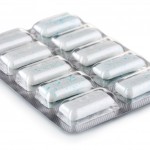
The use of sugar-free chewing gum may be a possible adjunct to caries prevention strategies. This could result from stimulation of saliva, mechanical plaque control of as a carrier for bacteriostatic agents such as xylitol or sorbitol. Two reviews more than a decade ago (Mickenautsch et al. 2007; Deshpande and Jadad 2008) suggest a caries reduction with sugar-free chewing gum (SFG).
THE aim of this review was to determine the difference in level of dental caries in adults and children who chew sugar-free gum (SFG), compared with those who do not chew SFG or use alternatives such as lozenges, candies, rinses, tablets, and other nonchewing controls.
Methods
Searches were conducted in the Medline, Embase PsycINFO, Scopus, Web of Science, Allied and Complementary Medicine Database (AMED), Cochrane Central Register of Controlled Trials (CENTRAL) and Open Grey databases. Randomised controlled trials (RCTs) crossover trials (minimum 1 week ‘washout’ period) pre-post trials, pre-post 1-arm trials, post-only trials and any design with a comparative arm and published in English were considered. The primary outcome was caries, with additional data on adverse effects, acceptability and implementation being collected.
Two reviewers screened and selected studies with disputed being settled by a third reviewer. Three reviewers independently extracted data and assessed risk of bias using the Cochrane tool. 3 summary measures were calculated (PF), standardised mean difference (SMD), and standardised effect size (ES) and a random effect meta-analysis carried out.
Results
- 12 studies (11 RCTs, 1 pre-post study) reported in 17 articles were included.
- Follow up period ranged from 7 weeks to 6 years with 8 studies having follow up of 2 years or more.
- None of the 12 studies was at low risk for all domains of the risk of bias tool with 9 studies being at high risk for one or more domains.
- 8 of the 12 studies used xylitol
| PF (95%CI) | SMD (95%CI) | ES (95%CI) | |
| All 12 studies | 28% (7% to 48%) | 0.32 (0.09 to 0.54) | -0.33 (-0.62 to -0.05) |
| Xylitol studies only | 33% (4% to 61%) | 0.39 (-0.01 – 0.79) | -0.4 (-0.81 to 0.02) |
Conclusions
The authors concluded: –
there is evidence to support the use of SFG in the control of dental caries in children. Further research is required to assess the effect of SFGs on caries incidence in adults and the specific value of using xylitol in this regard.
Comments
While an effect on plaque control is one of the actions by which SFG may exert its effect a recent review (Dental Elf – 25th Jun 2013) only found weak evidence for a positive effect on plaque indices. For this new review the authors have searched a wide range of databases however they have restricted their inclusions to studies published in English. They identified 15 papers not available in English indicating that 6 of these were specifically related to SFG use and caries, this may have implications for the findings. The reviewers did not assess publication bias and also did not indicate whether any of the included studies were funded by manufacturers although they did note that this research itself received a grant from Mars Wrigley. With the exception of 1 RCT conducted in adults over 60 and 1 trial with mother and child dyads the remaining studies were conducted in children in the range 6 -14 years of age.
Given that a majority of the included studies were RCTs restricting the inclusion to RCTs would have been appropriate. None of the included studies were at low risk of bias and the authors highlight a concern regarding the possibility of selective reporting. There is also a high level of heterogeneity in relation to dosage and frequency of gum use. As noted by the authors there is no reporting of adverse effects with few studies reporting active data gathering. There are also environmental concerns, school policy objections and a perceived risk of chocking. So, while the review suggests a preventive fraction in the order of 28% the confidence intervals are wide (7% to 48%) some caution is required.
Links
Primary Paper
Newton JT, Awojobi O, Nasseripour M, et al. A Systematic Review and Meta-Analysis of the Role of Sugar-Free Chewing Gum in Dental Caries [published online ahead of print, 2019 Nov 19]. JDR Clin Trans Res. 2019;2380084419887178. doi:10.1177/2380084419887178
Other references.
Mickenautsch S, Leal SC, Yengopal V, Bezerra AC, Cruvinel V. Sugar-free chewing gum and dental caries: a systematic review. J Appl Oral Sci. 2007;15(2):83–88. doi:10.1590/s1678-77572007000200002
Deshpande A, Jadad AR. The impact of polyol-containing chewing gums on dental caries: a systematic review of original randomized controlled trials and observational studies. J Am Dent Assoc. 2008;139(12):1602–1614. doi:10.14219/jada.archive.2008.0102
Dental Elf – 25th Jun 2013
Weak evidence for positive effect of medicated sugar-free chewing gum on plaque indices
